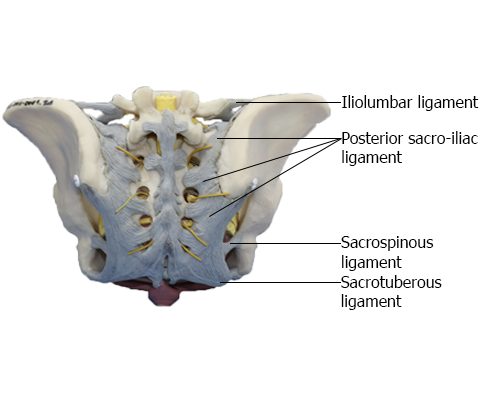Main Model

LIGAMENTS OF PELVIC GIRDLE : Ligaments posterior view

Joints and Ligaments of Pelvic Girdle
The primary joints of the pelvic girdle are the sacro-iliac
joints and the pubic symphysis. The sacro-iliac
joints link the axial skeleton (skeleton of the trunk, composed of the vertebral column at this level) and the inferior
appendicular skeleton (skeleton of the lower limb). The lumbosacral and sacrococcygeal joints, although joints of the
axial skeleton, are directly related to the pelvic girdle. Strong
ligaments support and strengthen these joints.
Sacro-iliac Joints
The sacro-iliac joints are strong, weight-bearing compound
joints, consisting of an anterior synovial joint (between the ear-shaped auricular surfaces of the sacrum and ilium, covered with articular cartilage) and a posterior syndesmosis (between
the tuberosities of these bones). The auricular
surfaces of this synovial joint have irregular but congruent
elevations and depressions that interlock.
The sacro-iliac joints differ from most synovial joints in that
limited mobility is allowed, a consequence of their role in
transmitting the weight of most of the body to the hip bones.
Weight is transferred from the axial skeleton to the ilia via
the sacro-iliac ligaments, and then to the femurs
during standing, and to the ischial tuberosities during sitting.
As long as tight apposition is maintained between the articular surfaces, the sacro-iliac joints remain stable. Unlike a keystone at the top of an arch, the sacrum is actually suspended
between the iliac bones and is firmly attached to them by
posterior and interosseous sacro-iliac ligaments.
The thin anterior sacro-iliac ligaments are merely the
anterior part of the fibrous capsule of the synovial part of the
joint. The abundant interosseous sacroiliac ligaments (lying deep between the tuberosities of the
sacrum and ilium and occupying an area of approximately
10 cm2) are the primary structures involved in transferring the weight of the upper body from the axial skeleton to the
two ilia of the appendicular skeleton.
The posterior sacro-iliac ligaments are the posterior
external continuation of the same mass of fibrous tissue. Because the fibers of the interosseous and posterior sacro-iliac ligaments run obliquely upward and outward
from the sacrum, the axial weight pushing down on the sacrum actually pulls the ilia inward (medially) so that they compress
the sacrum between them, locking the irregular but congruent
surfaces of the sacro-iliac joints together. The iliolumbar ligaments are accessory ligaments to this mechanism.
Inferiorly, the posterior sacro-iliac ligaments are joined
by fibers extending from the posterior margin of the ilium
(between the posterior superior and posterior inferior iliac
spines) and the base of the coccyx to form the massive sacrotuberous ligament. This ligament passes from the posterior ilium and lateral sacrum and coccyx to the ischial
tuberosity, transforming the sciatic notch of the hip bone into a large sciatic foramen. The sacrospinous ligament, passing from lateral sacrum and coccyx to the ischial spine, further subdivides this foramen into greater and lesser sciatic foramina.
Most of the time, movement at the sacro-iliac joint is limited by interlocking of the articulating bones and the sacro-iliac
ligaments to slight gliding and rotary movements.
When landing after a high jump or when weightlifting in the
standing position, exceptional force is transmitted through
the bodies of the lumbar vertebrae to the superior end of the
sacrum. Because this transfer of weight occurs anterior to the
axis of the sacro-iliac joints, the superior end of the sacrum
is pushed inferiorly and anteriorly. However, rotation of the
superior sacrum is counterbalanced by the strong sacrotuberous and sacrospinous ligaments that anchor the inferior end of
the sacrum to the ischium, preventing its superior and posterior
rotation. By allowing only slight upward
movement of the inferior end of the sacrum relative to the hip bones, resilience is provided to the sacro-iliac region when the
vertebral column sustains sudden increases in force or weight.
Pubic Symphysis
The pubic symphysis consists of a fibrocartilaginous interpubic disc and surrounding ligaments uniting the bodies of
the pubic bones in the median plane. The interpubic disc is generally wider in women. The ligaments joining
the bones are thickened at the superior and inferior margins
of the symphysis, forming superior and inferior pubic ligaments. The superior pubic ligament connects the superior
aspects of the pubic bodies and interpubic disc, extending as
far laterally as the pubic tubercles. The inferior (arcuate)
pubic ligament is a thick arch of fibers that connects the
inferior aspects of the joint components, rounding off the subpubic angle as it forms the apex of the pubic arch.
The decussating, fibers of the tendinous attachments of
the rectus abdominis and external oblique muscles also
strengthen the pubic symphysis anteriorly.
Lumbosacral Joints
L5 and S1 vertebrae articulate at the anterior intervertebral (IV)
joint formed by the L5/S1 IV disc between their bodies and at two posterior zygapophysial joints (facet joints)
between the articular processes of these vertebrae.
The facets on the S1 vertebra face posteromedially, interlocking
with the anterolaterally facing inferior articular facets of the L5 vertebra, preventing the lumbar vertebra from sliding anteriorly down the incline of the sacrum. These joints are further
strengthened by fan-like iliolumbar ligaments radiating from
the transverse processes of the L5 vertebra to the ilia.
Sacrococcygeal Joint
The sacrococcygeal joint is a secondary cartilaginous joint with an IV disc. Fibrocartilage and ligaments join
the apex of the sacrum to the base of the coccyx. The anterior and posterior sacrococcygeal ligaments are long
strands that reinforce the joint.